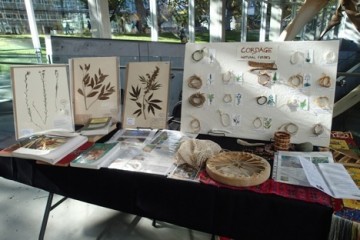
My cordage display with UBC Herbarium specimens for Linum, Apocynum, and Cannabis species; books on ethnobotany, plant technology, and string figures (cat’s cradle) from around the world; samples of items made with different kinds of string, including a cotton netted bag, a Guatemalan weaving, a Kwakwaka’wakw drum, a cedar bark basket, and a Tibetan embroidered wall hanging. Photo by Jackie Chambers.
String, rope, twine, cordage – what’s the big deal? String is one of the most important, yet under-acknowledged, of all of human technology – and for the vast majority of our history, it was made from plant and animal fibres.
On October 5th, on behalf of the UBC Herbarium and the Beaty Biodiversity Museum, I set up an Ask An Expert table to teach people about the importance of string in human culture, and the biodiversity of plants that have made it possible. Without string, there would be no Egyptian pyramids. Without string, sailing and exploration would not have been possible: the Polynesians would never have settled the myriad islands of the South Pacific; the Europeans and others would never have been able to circumnavigate the globe. Further back in history, without string there would be no fishnets or fishing lines, no snares or bows, no woven fabric for clothing, no reins or harnesses for domesticating animals, no bindings for shelters, or drills for fire, no hammocks, cradles, or stitched up shoes – in short, it’s entirely possible that the evolution and survival of the human being was completely dependent upon the evolution of this one simple skill: twisting fibres into string.
Some of the plants used throughout history have included hemp (Cannabis spp.), sisal (Agave spp.), flax (Linum spp.), and manila hemp (Musa textilis). Here in British Columbia, people have traditionally used dogbane (Apocynum spp.), stinging nettles (Urtica dioica), willows (Salix spp), cattails (Typha spp.), bull kelp (Nereocyctis luetkeana) and Western redcedar (Thuja plicata), to name but a few.
The plants are still all around us, but the knowledge of how to use them is waning.
The UBC Herbarium, housed in the Beaty Biodiversity Museum, is a hub of botanical research for the university and the broader botanical community. Aware of how important it is for people to keep their knowledge of plants alive, they have joined with the museum to set up educational opportunities for students and the public to learn more about plants in their midst – from the taxonomic to the molecular to the everyday ethnobotanical. As a student of ethnobotany (the study of the relationship between plants and people), and a work-learn student at the Herbarium, I was thrilled to have the opportunity to teach museum visitors how to make string from local plant materials. Despite the sunny weather, over 50 people visited the museum that Sunday, each one engaging with the information and skills I showed them. Their enthusiasm was delightful. It seems that even if the skill is no longer taught in our urban environments, the interest in string is veritably woven into our DNA.
I had local cattail and dogbane, as well as fibre from the raphia palm, to instruct people in the basic reverse-wrap technique. For most people this was new information, but for several people it was deeply familiar.
A woman from India shared stories of making rope from jute (Corchorus spp.) with her grandparents by the retting ponds in their backyard. She also said that every household in the village had a cotton field in the back, tended by the women who spin the fibres and weave them into cloth.
A family from Mexico knew about making rope from agave fibres, but were still excited to learn the reverse-wrap technique with local BC plants. The father worked in a textile plant and was able to tell me, in detail, about the different micron widths of natural and synthetic fibres and how he combined them and various metals to make an array of anti-flammable materials at the factory.
A woman from southern China said that she’d grown up rolling string on her thigh – one of the quickest and easiest string-making techniques practised in much of the world. Her teenage son, however, perhaps raised here in Vancouver, seemed to have never heard of making string from plants, and was practising the skill for the first time. As I instructed him, his mother leaned over his shoulder, correcting his technique.
Each person walked away expressing gratitude at having learned a new skill – one so simple and easy, and so potentially useful, once you know how to do it, and what plants to look out for.
Here are few more pictures from the event:
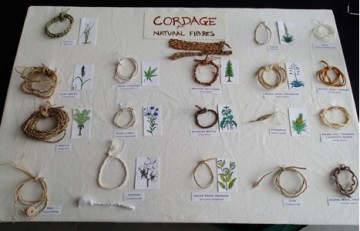
A cordage sample board showing string made from many different plants, including cotton, cattail, nettle, cedar, agave, and hemp; as well as from animal fibres such as wool, silk, leather, and sinew. Photo by Jackie Chambers.
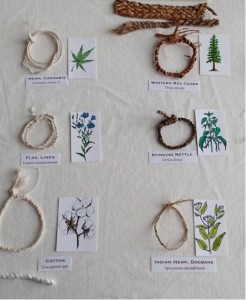
A close-up of the sample board, showing the colours and textures of the different fibres – the nettle fibre shown here wasn’t retted in the traditional way – usually it’s much more refined! Photo by Jackie Chambers and Saskia Wolsak.
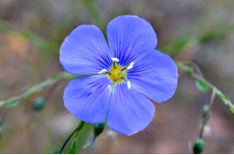
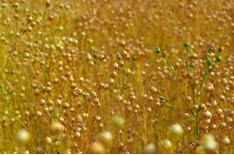
A species of Linum (flax) growing wild in Colorado, and a field of Linum usitatissimum grown in California for seed. Some people didn’t realise that this genus of plant gives them both their linen cloth as well as the flax seeds in their breakfast cereal; for many was an education in the plants that are at the source of their daily lives. Photos by Saskia Wolsak.
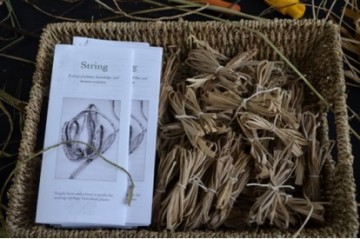
People took home a pamphlet including information on how to make string from the cordage plants of BC, as well as some raffia to practice with. Photo by Saskia Wolsak.
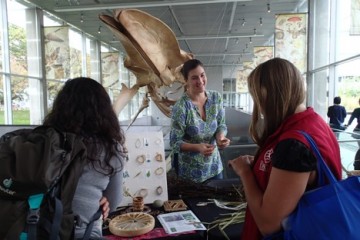
Beaty Biodiversity Museum employees and friends came by to learn about cordage too… Photo by Jackie Chambers.
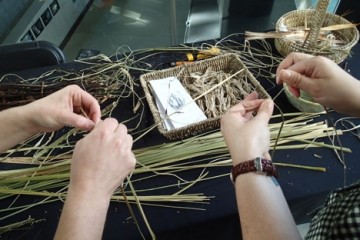
They practiced their new-found knowledge of an ancient skill….Photo by Jackie Chambers.
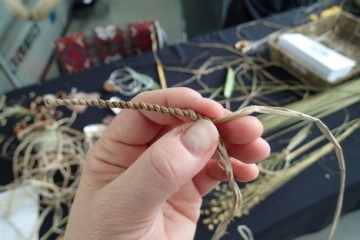
the reverse-wrap! Photo by Jackie Chambers.

Saskia Wolsak is a UBC student studying ethnobotany; she is also a work-learn student at the UBC Herbarium. Photo by Jackie Chambers.
